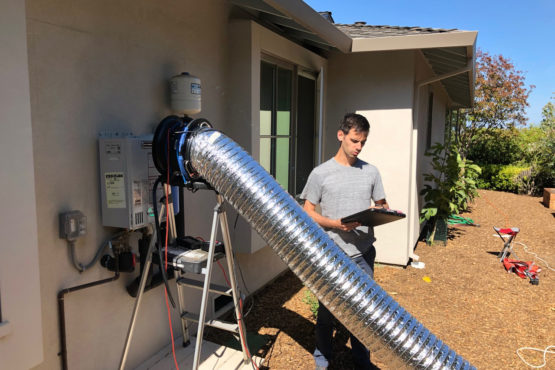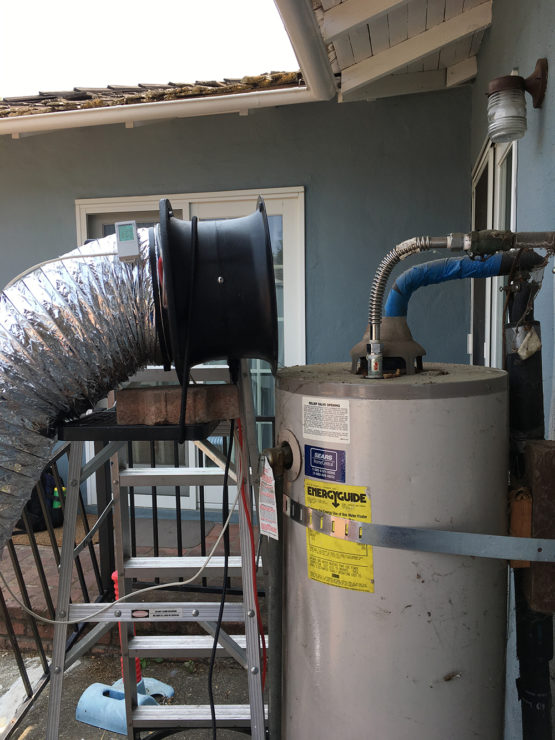Stanford researchers find methane leaks from U.S. water heaters are high, but fixable
Emissions of methane, a potent greenhouse gas, from water heaters are higher than previously estimated, especially for a new type of heater growing in popularity, a new Stanford study finds. But simple fixes exist.
Natural gas escapes from water heating systems through leaks and because some is not combusted by the burner. These tiny inefficiencies can add up: The resulting emissions of methane – a powerful greenhouse gas – for water heaters across the United States are potentially more than three times higher than expected, according to a new Stanford study. The good news, however, is that simple fixes are available that can be applied across most of the world’s economies.

Stanford staff researcher Colin Finnegan records notes as a Duct Blaster captures the methane being emitted from the tankless water heater on the side of a house in the study. (Image credit: Rob Jackson)
“These appliances are letting less than 1 percent of their gas escape, but so is the natural gas production at the opposite end of the system, and then we have all the leaky pipelines and meters in between,” said Rob Jackson, the study’s senior author and a professor of Earth system science at Stanford University’s School of Earth, Energy & Environmental Sciences (Stanford Earth). “Fixing gas leaks is an iterative challenge. For water heaters, we know what we have to do.”
Natural gas systems, from well pads to stovetops, are leaky. The gas that escapes into the atmosphere, whether from a broken valve on a pipeline or from the seconds when a burner has not yet caught the pilot light, is 90 percent methane. Methane is many times more effective at trapping heat than carbon dioxide and is responsible for almost a fourth of the warming in Earth’s atmosphere from all greenhouse gases. Over the past five to 10 years, much work has focused on finding and fixing these leaks.
“Wasted natural gas from appliances in homes and commercial buildings is probably the least understood cause of climate change from natural gas use,” said the new study’s lead author, Eric Lebel, a PhD student in Stanford’s Department of Earth System Science.
The researchers focused on water heaters because warming water accounts for a fourth of natural gas consumption in the average U.S. home that uses gas for hot water, cooking and heating. The 58 million U.S. water heaters that use natural gas leak around 91,000 tons of methane per year as uncombusted gas. Over 20 years, given methane’s much greater potency as a greenhouse gas than carbon dioxide, that 91,000 tons warms Earth as much as 7.8 million tons of CO2.
“That’s a very small part of total U.S. emissions, but it’s the equivalent of 1.7 million cars driving on gasoline for a year,” explained Jackson, who is also a senior fellow at Stanford’s Precourt Institute for Energy.
The study monitored water heaters in 64 homes in Santa Clara and San Mateo counties in California from June 2018 to November 2019. Though few studies have been performed on methane leakage by appliances, one study looked at natural gas water heaters in California and estimated that across the state emissions were about 5.4 billion grams. The new Stanford study – which includes more measurements of the on and off pulses in the newer type of tankless water heaters and more measurements of pilot light emissions from conventional storage water heaters – estimates that figure for California at 17.7 billion grams, more than three times as much.
Storage tank vs. tankless
The study found a very significant difference in emission rates between those two basic types of natural gas water heaters. The conventional natural gas water heater stores heated water in a tank. The other, newer type of heater has no tank. When a hot-water faucet is opened, the tankless water heater immediately fires up the gas to warm flowing water. A very small but growing number of U.S. water heaters are tankless. In Europe and Asia, around one in five systems does not store hot water. Globally, tankless systems are growing at an annual rate above 7 percent.

A Duct Blaster captures the methane being emitted from the storage water heater outside a home in the study. (Image credit: Simone Speizer)
“Since that growth trend is expected to continue, we thought it important to compare the two models,” said Lebel. “On average, we found about twice as much methane emissions from tankless water heaters than from storage water heaters.”
However, tankless heaters are more efficient. They burn less natural gas per gallon of hot water than conventional systems and therefore produce less carbon dioxide. In total, tankless water heaters emit 18 percent less greenhouse gases than storage water heaters.
Fortunately, because tankless water heaters are just still just becoming more popular, especially in North America, new models can be re-engineered to reduce leaked and uncombusted natural gas. Anyone who has been near a water heater or space heater when it fires up has heard the burst of combustion at the beginning of a cycle; this is when a burst of natural gas escapes uncombusted. Methane is also released when the unit shuts down. This is true for both types of water heaters.
But, for tankless heaters the on/off pulses account for almost 60 percent of emitted methane. Tankless models turn on and off every time a hot water faucet is opened and shut. Stored water is heated or reheated periodically. The researchers suggest that the on/off pulses of tankless water heaters can be lowered significantly to reduce methane leakage without reducing their performance.
“We find other pretty simple design fixes, too,” said Jackson. “For heaters with tanks, most of the release of uncombusted gas is from the pilot light when the heater is idle. Standard pilot lights should be replaced with electronic igniters.”
The study also finds that the growing popularity of single handle faucets should be reconsidered, regardless of heater type.
“With single handle faucets, people trigger hot water draws unknowingly by moving the handle straight up and then to the cold side. Or they go for hot water but then decide they’re really not willing to wait for it,” Jackson said. “It’s a simple but pointless source of emissions of both methane and CO2 that is multiplied every day.”
Rob Jackson is Stanford’s Michelle and Kevin Douglas Provostial Professor and a senior fellow at the Stanford Woods Institute for the Environment. Co-authors of the paper in Environmental Science & Technology include Harmony S. Lu, Simone A. Speizer and Colin J. Finnegan, all of Stanford’s Department of Earth System Science. Speizer’s work on this project was funded by a Stanford Undergraduate Program in Energy Research internship.
To read all stories about Stanford science, subscribe to the biweekly Stanford Science Digest.
